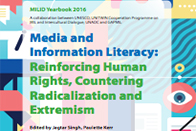The United Nations Alliance of Civilizations’ High Level-Group Report recognizes that “The constant exposure of populations to media presents an educational challenge, which has increased in the electronic and digital age. Evaluating information sources requires skills and critical thinking and is an educational responsibility the importance of which is often underestimated. Separating fact from opinion, evaluating text and image for bias, and constructing and deconstructing a text based on principles of logic are teachable skills. Media literacy instruction is not widely recognized for its importance as an aspect of civic and peace education and therefore few instructional programs have been developed as part of basic modern education.” The Report recommends that “Media literacy programs should be implemented in schools, particularly at the secondary level, to help develop a discerning and critical approach to news coverage by media consumers and to promote media awareness and development of Internet literacy to combat misperceptions, prejudices and hate speech.”
To that end, UNAOC has developed a wide range of Media and Information Literacy (MIL) initiatives:
PLURAL+ Youth Video Festival
 PLURAL+ Youth Video Festival focuses on the themes of migration, diversity and social inclusion, developed in partnership with IOM.
PLURAL+ Youth Video Festival focuses on the themes of migration, diversity and social inclusion, developed in partnership with IOM.
PEACEapp
 PEACEapp is a series of projects using ICT, gamified apps, and videogaming for intercultural dialogue.
PEACEapp is a series of projects using ICT, gamified apps, and videogaming for intercultural dialogue.
MIL clearinghouse
 MIL clearinghouse, a web-based multi-lingual platform for the dissemination of MIL resources and information developed in partnership with UNESCO.
MIL clearinghouse, a web-based multi-lingual platform for the dissemination of MIL resources and information developed in partnership with UNESCO.
MIL Curriculum for Teachers
 MIL Curriculum for Teachers, the interactive version of UNESCO’s MIL curriculum.
MIL Curriculum for Teachers, the interactive version of UNESCO’s MIL curriculum.



